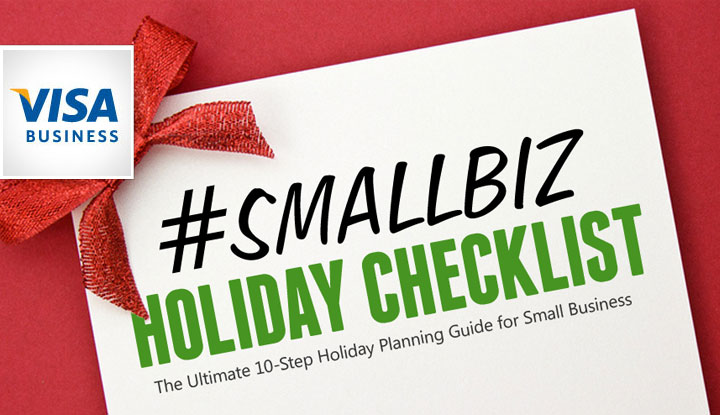From Black Friday to Cyber Monday and the holidays we hold near and dear – ‘tis the season to be jolly and stressed. In fact, for small business owners, planning for the holiday season can often overwhelm the best of us. While there are seemingly a million and one things your company needs to do this holiday season, there are key areas that can cover-off on your most pressing concerns.
Sponsored Article. This post is brought to you by Visa Business and I receive compensation for my time from Visa for sharing my views in this post, however the views expressed here are solely mine, not Visa’s. Visit http://facebook.com/visasmallbiz to take a look at their reinvented Facebook Page: Well Sourced by Visa Business.
The Page serves as a space where small business owners can access educational resources, read success stories from other business owners, engage with peers, and find tips to help businesses run more efficiently. Every month, the Page will introduce a new theme that will focus on a topic important to a small business owner’s success. For additional tips and advice, and information about Visa’s small business solutions, follow @VisaSmallBiz and visit www.visa.com/business.
Here’s a quick look at ten steps every small business owner should take before opening their online and physical doors during the holiday season:
1. Beat the holiday stress before it comes
The holiday season is stressful for companies and consumers, alike. Beat the pre-season stress by tackling key issues early. For instance, strenuous time demands from work and family obligations during the holidays can be overwhelming. It is “the time of year that life comes before work,” according to Bed Rest Concierge CEO, Stephanie Johnson.
Like many small business owners, Johnson tries to “find a balance … [during] a time of year when work-life balance is very important,” she says. Start by developing a balanced schedule, delegating key tasks to team members and scheduling time with family and friends ahead of time.
2. Identify business process bottlenecks, immediately
A bottleneck occurs when demand comes faster than the next step can use it to create supply. Holiday surges in demand often reveal bottlenecks within your company, resulting in limited scale and strained resources. Catch them before they start.
First, empower employees to make good decisions by giving them room to make the call. Every decision doesn’t need a committee of you; and if so, it is time to outline and distribute operational guidelines for all employees. Instead of calling you, they will know what to do because it is at their disposal – in writing.
Next, prevent bottlenecks that cripple operations. Employees will become sick or take impromptu vacations during the holidays. What happens when no one else is qualified to take over their work? Cross train employees to learn key functions outside of their role, should the need arise for “all hands on deck.”
Lastly, take note of daily processes that already suffer delays and develop a mock stress test to see how your business performs when timelines are tightened or when project steps experience roadblocks.
3. Set financial goals for the holiday season
Schedule a meeting with your accountant (or dust off your company financial statements) and set revenue goals for the holiday season. Understanding your financial picture will guide budgeting, compensation, benefits, costs, revenues and more.
Most importantly, keep all team members informed of the financial picture to ensure they remain in-budget and realize how their work impacts the company’s success. If you need on-demand accounting help, try no-obligation, subscription-based accounting services like 1800Accounting or virtual accounting firms.
4. Connect with trusted business partners, early
Now is the time to shore up your supply chain. A chain is only as strong as its weakest link. How fast, efficient, and dependable are your suppliers? Will they rise to the occasion when you need them? Make the calls early to assess where your company fits into their bigger picture. Determine what consolidated lead times will do to your budget; consider how logistics delays – getting products and services to customers – will strain resources and impact sales.
Don’t hold back. Remain transparent about your needs. Most importantly, identify “pinch hitters” – suppliers that can step up to the plate as a substitute when key players do not actively meet business needs. Your supply chain is a strategic asset – “speed and adaptability drive success in a volatile world,” according to multinational professional services company PwC. And let’s face it – the holiday season is extremely volatile.
5. Refresh your sales promotion schedule
Sales promotions are a key driver of holiday season marketing activities. From product sampling and coupons to rebates, giveaways, events and premiums; offering incentives is a proven sales driver.
Refresh sales efforts by outlining promotions offered during the holiday season. Address the following areas: timing, costs, where you will offer promos (i.e. distribution channels), and how you will track and measure success (i.e. analytics). Lastly, ensure that you can meet demand.
6. Reinforce your customer service ‘right to win’
Holiday shopping brings good tidings, cheer, and customer worries. “As we approach holiday shopping time, many of us [including your customers] start thinking about long lines, frayed nerves and dealing with frazzled customer-service representatives,” according to In Business Magazine.
The customer experience should become a primary focal point for your business during the holidays – as it can make or break your bottom line. The customer service blog at Fonolo explains, “Today, a poor customer experience doesn’t stop on the phone; they will candidly share this information with the rest of the world using numerous social media outlets – impacting brand image and perception.”
Technology can ease the burden. For example, eliminate call hold time using call-back solutions, like Fonolo, that replace hold time with a call-back, regardless of the channel – web, mobile and phone.
7. Test drive your company website
Ensure your company’s website is correct, updated and chock-full of need to know information that online buyers need. Are your store policies up-to-date? Do you offer adequate product and service information? How are you going to win over browsers as soon as they land on your e-commerce storefront? Will you offer real-time engagement including live chat technology?
For instance, online self help can drive sales when customers have access to 24×7 chats with a product expert or customer support representative. “According to a 1,000 person consumer survey by the E-Tailing Group and Bold Software, 20% of online shoppers select live chat as their preferred method of communication with a retailer.” (Source: LiveHelpNow)
Also get ready to tackle showrooming and webrooming. Studies suggest that, “65 percent of online shoppers intend to “webroom” this holiday season. This means browsing online for a product and then going to a store to make the purchase. Consumers webroom in order to avoid shipping costs and to touch and hold the product before making a final decision.”
Offer free shipping, create video demonstrations and highlight guiltless return policies to combat these behaviors. Ultimately, your company website should help customers help themselves and choose your brand when gripped with a myriad of competitive choices.
8. Attract new customers with co-marketing efforts
Two brands are better than one. Co-marketing activities are a win-win for complimentary businesses. Think Intel Inside program, Pillsbury Brownies with Nestlé Chocolate or the Nike and Apple Sports Kit – matches made in marketing heaven. As HubSpot writer Amanda Sibley explains, “In a co-marketing partnership, both companies promote a piece of content or a product, and share results of that promotion with each other.”
For example, if you own a local gym, partner with a spa owner to offer mutual discounts on gym memberships and spa services. So, when James purchases a gym membership he receives a free massage. Inversely, when Sally purchases spa treatments she receives a discounted gym membership. Start by developing three co-marketing ideas, reach out to prospective partners, draft a co-marketing agreement and collaborate to ramp up holiday business.
9. Compete against larger competitors with inbound marketing
If inbound marketing isn’t on your to-do list – it should be! HubSpot reports confirm, “Nearly 60% of companies are already practicing inbound marketing tactics.” Meanwhile the same report suggests, “Inbound marketing delivers 54% more leads into the marketing funnel than traditional outbound leads.”
By definition, inbound marketing earns the attention of customers, makes it easier for customers to find you, and draws attention to your business. Instead of a push, it’s a pull to reel in ideal customers.
To get started with inbound marketing make sure, at least, one of these tactics are top of mind over the holidays: company blogging, online video, ebooks, email newsletters, social media marketing, search engine optimization (SEO), search engine marketing (SEM), infographics or standard content marketing tactics.
10. Review staffing plans and ramp up as needed
Holiday staffing can be a headache. From extending work hours to temporary staffing solutions, most small business owners don’t welcome the task. Couple this demand with employee vacations and family gatherings that prompt a lot of time-off requests and it can be a recipe for disaster. Without a holiday staffing plan your company’s productivity, team morale, and sales can suffer.
Now is the time to communicate employee expectations, process time-off requests, move part-time workers to full-time status, elevate temporary staff to part-time, hire new interns, and hope for the best! As a fail-safe mechanism, don’t leave holiday staffing to chance. Reach out to temporary staffing agencies early for on-demand, same day staffing and reward employees that shine during the busy holiday season.
11. Bonus: Reward your top customers and employees
A holiday planning guide would not be complete without remembering the reason for the season. The holidays present the perfect time to give back to key customers and staff that champion and drive your business forward.
Corporate gifting is an excellent way to show your appreciation. Make a list of your key customers, employees and partners that have contributed real results to your organization. Next, set aside a discretionary spending account and send a personalized thank you card along with a gift. And remember: giving corporate gifts doesn’t have to be extravagant – it is the thought that counts.
© YFS Magazine. All Rights Reserved. Copying prohibited. All material is protected by U.S. and international copyright laws. Unauthorized reproduction or distribution of this material is prohibited. Sharing of this material under Attribution-NonCommercial-NoDerivatives 4.0 International terms, listed here, is permitted.




